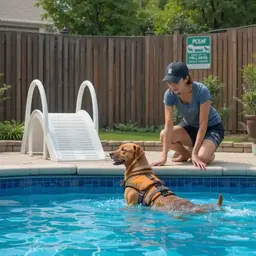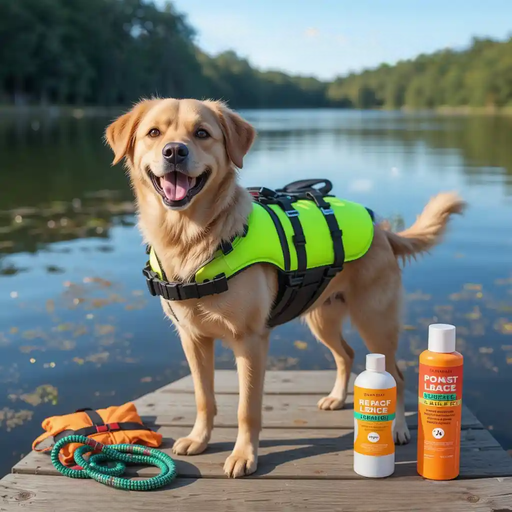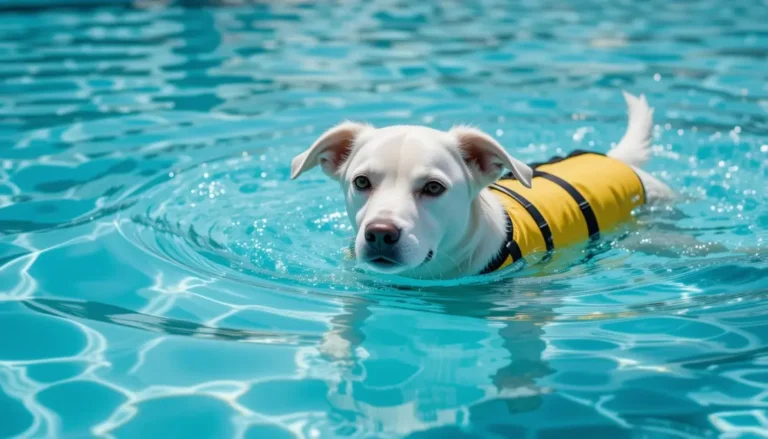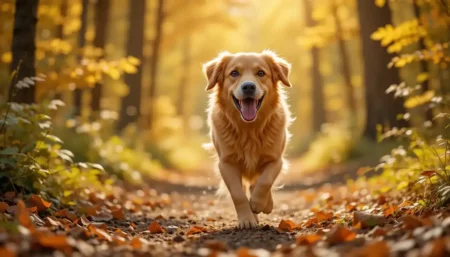Dog water safety is critical for preventing drowning accidents. Never assume your dog can swim naturally. Key precautions include:
- Constant supervision near water
- Properly fitted life jackets
- Teaching pool exit strategies
- Recognizing high-risk breeds
- Learning canine CPR for emergencies
Every year, preventable water accidents claim canine lives due to owner misconceptions about swimming abilities. This comprehensive guide provides actionable strategies to protect your pet during water activities, transforming potentially dangerous situations into safe, enjoyable experiences for both of you.
Understanding Water Risks for Dogs
The most dangerous misconception in dog water safety is believing all dogs are natural swimmers. While many dogs display a “doggy paddle” instinct when in water, this is often a panicked survival reflex rather than a coordinated swimming ability. This instinctive movement doesn’t guarantee they can stay afloat for extended periods or navigate back to safety.
Many dogs quickly become exhausted, especially in deeper water, leading to drowning within minutes. The reality is that swimming is a learned skill requiring practice, confidence, and physical capability—factors that vary significantly between individual dogs and breeds.
Without proper introduction and supervision, even seemingly shallow water can become deadly. Understanding this crucial distinction between instinctive movement and actual swimming proficiency is the foundation of effective dog water safety.
Breeds at Highest Risk in Water
Dogs with shortened snouts face serious disadvantages in water environments. Their anatomy creates multiple challenges:
- Bulldogs, Pugs, Boxers, and Boston Terriers struggle with breathing while swimming
- Heavy chest muscles cause them to sink rather than float
- Short muzzles make it difficult to keep the airways clear of water
- Excessive facial skin can obstruct vision and breathing
These breeds often tire within minutes in water and require constant supervision with a properly fitted life jacket. Never force these dogs into water—many simply cannot swim safely regardless of training.
Short-Legged and Long-Body Breeds: Propulsion Problems
Dachshunds, Basset Hounds, and Corgis face unique challenges in water:
- Short legs provide minimal propulsion power
- Long bodies create drag and make maneuvering difficult
- Rapid exhaustion occurs even in calm water
- Back problems can worsen with improper swimming technique
These breeds often appear to “doggy paddle” but quickly become fatigued. Their swimming ability is severely limited compared to breeds with longer limbs and streamlined bodies.
Sighthounds: The Buoyancy Factor
Whippets, Greyhounds, and other sighthounds have lean body types with low body fat percentage, resulting in poor natural buoyancy. Their narrow chests and deep bodies make it difficult to stay afloat without significant effort. These dogs often sink rather than float and require immediate assistance if they enter deep water unexpectedly.
Common Water Environments and Their Hidden Dangers
Swimming Pools
Swimming pools represent one of the most significant drowning hazards for dogs, yet many owners underestimate the risks:
- Steep, vertical walls with limited exit points—dogs often cannot locate the pool steps
- Slippery surfaces around pool edges cause accidental falls
- Pool covers can trap dogs underwater if they fall through
- Chemical imbalances can irritate eyes and skin, causing panic
Unlike natural bodies of water with gradual slopes, pools present unique challenges that can quickly turn a fun dip into a life-threatening situation. Even dogs that swim well in lakes may struggle to exit a standard residential pool.
Natural Bodies of Water
Lakes, rivers, and oceans introduce additional risks beyond basic swimming ability:
- Strong currents and undertows can pull even strong swimmers away from shore
- Cold water temperatures cause rapid exhaustion and hypothermia
- Hidden debris, like branches or rocks, can injure or trap dogs
- Water quality issues, including toxic algae blooms and pollution
Natural water environments change constantly with weather, season, and time of day. What appears safe in the morning may become dangerous by afternoon. Always check local conditions before allowing your dog in natural bodies of water.
Small Water Features
Many owners don’t consider seemingly harmless water sources as risks, but even shallow water can be deadly:
- Garden ponds with steep sides trap small dogs
- Bathtubs and buckets can drown puppies or small breeds
- Fountains and decorative water features have hidden dangers
- Irrigation ditches with fast-moving water pose serious risks
Never underestimate the drowning risk of even shallow water for dogs with limited mobility or swimming ability. A few inches of water can be fatal if a dog cannot escape.

Essential Water Safety Equipment for Dogs
A properly fitted life jacket is the single most important piece of dog water safety equipment, regardless of your dog’s swimming ability. Even strong swimmers can become fatigued, caught in currents, or experience medical emergencies while in the water.
Critical Features to Look For
When selecting a dog life jacket, prioritize these essential elements:
- Secure neck closure that prevents the jacket from sliding forward
- Strong handle for easy rescue and support
- High-visibility colors or reflective strips for better visibility
- Proper buoyancy for your dog’s size and weight
- Adjustable straps ensure a snug, comfortable fit
The jacket should allow a full range of motion while keeping your dog’s head above water. Always test the fit before water activities—your dog should be able to move freely, but the jacket shouldn’t shift position.
Top Recommended Dog Life Jackets
| Life Jacket | Best For | Key Features | Why It Excels |
|---|---|---|---|
| Ruffwear Float Coat | All-around protection | Telescoping neck, strong handle, reflective trim | Excellent buoyancy distribution, durable construction |
| Outward Hound Granby Splash | Budget-friendly option | Bright colors, dual grab handles, adjustable straps | Reliable performance at accessible price point |
| EzyDog DFD X2 Boost | Large & XL breeds | Up to 50% more flotation, heavy-duty polyester | Superior buoyancy for heavier dogs |
| HydroSaver Pro | Maximum safety | 360° visibility, emergency whistle, quick-dry fabric | Comprehensive safety features for high-risk situations |
Additional Safety Gear Worth Considering
Beyond life jackets, these items enhance your dog’s water safety strategy:
- Pool ramps or steps specifically designed for dogs
- Floating toys to encourage safe water entry and exit practice
- Water thermometers to check for dangerously cold temperatures
- Rinse stations to remove harmful contaminants after swimming
- Emergency flotation devices for quick rescue situations
For pool owners, consider installing a dog-specific pool ladder that provides a consistent, accessible exit point. These ramps are designed with non-slip surfaces and gradual inclines that dogs can easily navigate, even when tired.
Prevention Strategies by Water Environment
Swimming Pool Safety for Dogs
The Golden Rule: Constant Supervision
The single most effective dog water safety measure is constant, undivided supervision. Never leave your dog unattended near a pool, even for “just a minute.” Distractions like phones, conversations, or household tasks can lead to tragic outcomes in seconds.
Supervision guidelines:
- Stay within arm’s reach of your dog in or near water
- Maintain visual contact at all times—don’t rely on hearing splashes
- If you must leave the pool area, take your dog with you immediately
- Watch for subtle signs of fatigue: slower movement, lower head position, or irregular breathing
Teaching Pool Exit Strategies
One of the most valuable skills you can teach your dog is how to exit the pool independently. Practice this essential dog water safety skill regularly:
- Start with your dog on a leash near the pool steps
- Use a treat to guide them toward the exit point
- Reward immediately when they successfully exit
- Gradually reduce assistance until they locate the exit independently
Repeat this process multiple times during each pool session until your dog consistently finds and uses the exit. For added safety, consider teaching your dog to recognize a specific verbal cue for “exit now.”
Lake, River, and Ocean Safety Precautions
Navigating Natural Water Currents
Natural bodies of water present unique challenges that require specific dog water safety strategies:
- Check local water conditions before each outing—never assume conditions are safe
- Avoid areas with visible currents or posted warnings
- Stay close to shore where the water is shallower and the currents are weaker
- Use a long line in unfamiliar water to maintain control while allowing exploration
Be particularly cautious after rainfall, when rivers and streams often have stronger currents and debris. Even dogs that swim well in calm water can be overwhelmed by moving water.
Water Quality and Wildlife Concerns
Natural water environments introduce additional hazards beyond basic swimming:
- Blue-green algae can be toxic and fatal—avoid water with scum or unusual color
- Jellyfish and stingrays pose risks in ocean environments
- Snakes and alligators may inhabit certain freshwater areas
- Bacteria and parasites can cause serious illness
Always rinse your dog thoroughly after swimming in natural bodies of water to remove contaminants. Provide fresh drinking water to prevent them from consuming potentially harmful lake or river water.

Training Your Dog for Water Safety
The foundation of effective dog water safety is creating positive associations with water. Never force a dog into water, as this can create lifelong fear and resistance:
- Begin with shallow water, like a kiddie pool or bathtub
- Let your dog explore at their own pace with your calm presence
- Use high-value treats and enthusiastic praise for water exploration
- Keep initial sessions extremely short (2-3 minutes) to prevent overwhelm
Watch for signs of stress, including trembling, whining, or attempts to escape. If your dog shows discomfort, end the session immediately and try again another day.
Building Confidence Gradually
Once your dog feels comfortable with shallow water, gradually increase depth and duration:
- Support your dog’s chest with one hand while they paddle
- Move slowly to slightly deeper water as they gain confidence
- Introduce gentle splashing and water play to build comfort
- Always end sessions on a positive note before fatigue sets in
Focus on short, frequent sessions rather than infrequent long ones. Most dogs learn best with 5-10 minute sessions several times a week rather than hour-long sessions once a week.
Emergency Response Training
Recognizing Water-Related Distress
Understanding the signs of water distress can mean the difference between life and death:
- Early signs: Increased paddling effort, head held higher than normal
- Moderate distress: Inconsistent paddling, attempts to climb on you
- Critical distress: Vertical position in water, frantic movements, gasping
Many drowning dogs don’t make dramatic splashes or cries for help—they quietly slip beneath the surface. Stay alert to subtle changes in your dog’s swimming behavior.
Basic Canine CPR Steps
Knowing canine CPR could save your dog’s life in a water emergency:
- Remove from water while supporting the head and neck
- Clear the airway by tilting the head downward to drain water
- Check for breathing and pulse at the femoral artery
- Begin chest compressions at 100-120 per minute, 1/3 to 1/2 chest depth
- Give rescue breaths by closing the mouth and breathing into the nose
For every 30 compressions, give 2 rescue breaths. Continue until breathing resumes or you reach veterinary care. Even if your dog seems fine after a water incident, seek immediate veterinary attention as delayed complications can occur.
Special Considerations for Different Dogs
Brachycephalic Breeds: Extra Precautions Needed
Dogs with shortened snouts require specialized dog water safety approaches:
- Always use a life jacket with extra neck support
- Limit water exposure to very short supervised sessions
- Avoid deep water entirely—stick to shallow wading areas
- Monitor breathing closely for any signs of distress
These breeds often struggle to keep their airways clear while in water, making even brief exposure potentially dangerous. Never assume your bulldog or pug can handle water activities that other dogs enjoy.
Short-Legged and Long-Body Breeds: Unique Challenges
Dachshunds, Basset Hounds, and similar breeds need tailored safety approaches:
- Use specialized life jackets with extra buoyancy under the chest
- Provide frequent rest breaks during water activities
- Avoid strong currents that overwhelm their limited propulsion
- Consider hydrotherapy under professional supervision for joint issues
These dogs often tire quickly in water but may continue swimming out of determination, leading to dangerous exhaustion. Watch for signs they’re struggling to maintain position.
Age-Specific Water Safety
Puppies: Building Water Confidence Safely
Puppies need a careful introduction to water environments:
- Start with very shallow water, like a few inches in a bathtub
- Keep sessions extremely short (1-2 minutes maximum)
- Always use a life jacket for buoyancy and security
- Focus on positive experiences without pressure
Puppies lack the physical strength and coordination for extended swimming. Their temperature regulation is also less developed, making them susceptible to hypothermia even in warm water.
Senior Dogs: Adapting Water Activities
Older dogs face unique challenges in water that require modified safety approaches:
- Check with your vet before introducing swimming activities
- Use life jackets for support and reduced joint strain
- Limit session duration to prevent exhaustion
- Provide easy exit points and non-slip surfaces
Arthritis, heart conditions, and reduced stamina can make swimming dangerous for senior dogs without proper precautions. Swimming can be therapeutic for some conditions but requires careful monitoring.
Emergency Response and First Aid
Recognizing Water-Related Emergencies
Dry Drowning: The Silent Threat
“Secondary drowning” or “dry drowning” occurs when water enters the lungs, causing inflammation and fluid buildup hours after the incident. Symptoms may not appear immediately, making vigilance crucial:
- Persistent coughing or gagging
- Difficulty breathing or rapid breathing
- Lethargy or unusual tiredness
- Blue-tinged gums or tongue
- Disorientation or confusion
If your dog shows any of these symptoms after water exposure, seek immediate veterinary care. Early intervention can prevent fatal complications.
Near-Drowning Protocol
If your dog experiences a near-drowning incident, follow these steps:
- Remove from water immediately while supporting the head and neck
- Clear the airway by positioning the head downward
- Begin CPR if not breathing or no pulse
- Seek emergency veterinary care even if breathing resumes
Time is critical—every minute counts in water emergencies. Continue CPR during transport to the vet if necessary.
Building a Comprehensive Dog Water Safety Plan
Creating Your Personalized Safety Checklist
Develop a customized dog water safety plan that addresses your specific situation:
- Identify water risks in your home and regular walking routes
- Purchase appropriate safety gear for your dog’s size and needs
- Practice emergency drills monthly with family members
- Establish clear rules for water access and supervision
- Create a communication plan for water emergencies
Review and update your plan seasonally, especially before summer when water activities increase. Include all household members in training and practice sessions.
Seasonal Considerations for Year-Round Safety
Dog water safety needs change throughout the year:
- Spring: Beware of fast-moving runoff in rivers and streams
- Summer: Monitor for toxic algae blooms in lakes and ponds
- Fall: Watch for hidden hazards as water levels drop
- Winter: Prevent ice-related accidents on frozen bodies of water
In colder months, pay special attention to icy conditions where dogs may fall through thin ice. Even in winter, maintain your dog’s water safety awareness as unexpected water hazards exist year-round.
Frequently Asked Questions
How to know if water is safe for dogs?
Ensure water is clear, odorless, and free of visible pollutants (like algae scum, foam, or debris). For tap water, confirm it meets municipal safety standards. Avoid sources near industrial runoff or agriculture.
How do you make tap water safe for dogs?
Most tap water is safe for dogs to drink. If you are concerned about contaminants, use a certified water filter or boil the water for 1 minute and then cool it. Avoid adding chemicals like water softeners.
How to tell if water is safe for dogs?
Visually inspect for clarity and absence of scum, foam, or odd smells. For natural sources, check local advisories for bacteria/algae blooms. Stagnant water often harbors parasites.
What water should dogs not drink?
Dogs should avoid saltwater, stagnant ponds, water with blue-green algae (looks like paint), chemically treated pools, and any source contaminated with oils, antifreeze, or pesticides.
How to know if lake water is safe for dogs to swim in?
Check for posted warnings about bacteria/algae. Avoid water with visible green/blue scum, dead fish, or strong odors. Fast-moving water is generally safer than stagnant areas.
Conclusion
Dog water safety requires understanding that not all dogs are natural swimmers, recognizing environmental risks, and implementing consistent preventive measures.
Prioritize constant supervision, proper life jackets, and teaching exit strategies to transform water activities from potential hazards into safe, enjoyable experiences.
Remember that immediate veterinary care is crucial even after seemingly minor water incidents, as complications can develop hours later.
By integrating these practices into your routine, you’ll ensure your canine companion enjoys water activities with minimal risk—because their safety in and around water isn’t optional, it’s essential.
Start today by checking your pool’s exit accessibility and fitting your dog with a properly sized life jacket for your next water adventure.









